Seasonal Eating with Warming Winter Soup
I have been thinking over the past week and chatting with followers on The Bridge Cottage Way’s social media pages about our favourite warming winter soup and wondering which recipe to share with you. However, I wonder if we could think first about the basics of soup making to give you the confidence to experiment with what is to hand? I hardly ever use a recipe but look at what is in season in my local market, what vegetables are locally produced, what ingredients are lying lonely in the fridge and need finishing up or have been reduced in the shops and can be put to good use.
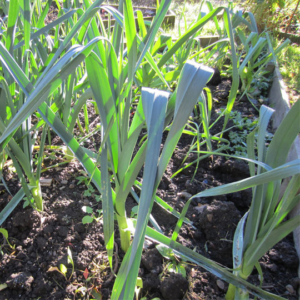
Looking at Leeks: Growing and Eating
The Bridge Cottage Way is all about reducing the drain on our planet’s precious resources, so we want to encourage folk to eat with the seasons, to eat food that has been locally produced where possible and not grown under plastic thousands of miles away, shipped over here by boat or plane and wrapped in single-use plastic. We talk about this a lot, and instead of thinking of it as a limiting practice, try reframing it to bring seasonal delight and variety to your diet.
It is midwinter here in the UK, and the only crops we have in the veg plot to use are leeks, kale and if the shrews have left us any, some Jerusalem artichokes (though beware of the latter – my mother-in-law calls it arty farty soup for good reason. The wind can be crippling!). In the local market, there are leeks, cauliflowers, carrots and parsnips: all perfect for winter soup.
The Basics of Soup Making.
- Clean, chop and sweat vegetables.
Place a small amount of olive oil or a knob of butter in the base of a heavy pan on very low heat then add chopped vegetables. Place the lid on and sweat for five to ten minutes. This draws out the flavour.
- Add stock.
We keep a jar of homemade fermented vegetable stock in the fridge. Or you could make a batch of vegetable stock and freeze in ready-to-use portions. You could try this vegetable stock recipe from our friends at River Cottage: River Cottage Vegetable Stock. (I see I need to add stock-making to the list of posts to write this year.) Or use a stock cube or spoon of Bouillon powder. Add enough stock to cover the vegetables and bring to a boil. You can always add more hot water if needed.
Meat eaters may also have stock in the freezer from boiling a chicken carcass or keeping the stock from boiling ham or cooking up lamb bones with water.
- Cook & Blitz
Cook your vegetables until soft – meaning a sharp knife point will go in easily, then blitz with a hand blender if you like smooth soups. To blitz or not to blitz, that is the question and a bone of contention in this house. Tim likes chunky soups and I like smooth. Or you may not own a hand blender ( a potato masher will break up big chunks). When the kids were small all soup had to be blended within an inch of its life or our daughter would not touch it. The grandkids are just the same. It’s also a cheeky way of getting veg into them unawares. Though to this day, our daughter can sniff out a pepper at a mile.
So that’s the basics, now I will give you a recipe. Doing a shop in a local supermarket, I saw chestnuts had been reduced post-Christmas, so grabbed a few packs to put in the store cupboard. They marry so well with parsnips in soup, or with leeks in risotto.
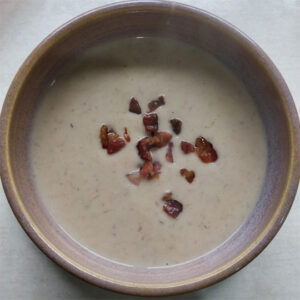
Warming Winter Soup. Parsnip and Chestnut.
Parsnip and Chestnut Soup.
1 kg parsnips
Knob of butter or 1tbsp veg or olive oil
180g bag whole chestnuts, rough chopped
1 pint veg or chicken stock
1 pint milk – oat or dairy.
Peel and chop parsnips then sweat in a tablespoon of oil or knob of butter with a lid on for five mins. Add stock and cook for fifteen minutes. Add chestnuts and continue to cook until the parsnips are soft.
Add milk and bring back to simmer.
Blitz and serve!
An alternative to chestnuts might be ginger – parsnip and ginger is another winning combination and most definitely warming for these cold January days. OR maybe bung in some carrots? There really are no rules. Meat eaters might like to start with finely chopped streaky bacon at the beginning, reserving some for croutons on the top as I have done in this photo.
I’m off to the fridge now where I know there is a sad-looking cauliflower and some Stilton left over from Christmas. I may add a leek and a few chopped potatoes for body too. Go experiment with your soup-making, but please, keep it seasonal, and do let us know how you get on!

Sue and Tim from The Bridge Cottage Way
As ever, we’d love you to share your thoughts, either by leaving a comment here or on our social media pages, where this article will be shared.
You can find the Bridge Cottage Way on Facebook Twitter and Instagram.
You might enjoy some of the writing and ideas in other sections of this website, as we look towards leading more sustainable lives by growing our own food and creating dishes in line with seasonal eating, or head to our handy ‘Month by Month’ guides to find out what we have been doing here at Bridge Cottage as the months go by:
Many thanks for reading.
With Facebook and Instagram algorithms being fickle friends at times, be sure to get all new posts from The Bridge Cottage Way by signing up for the mailing list by this link:
This will go out four times a year, with the seasons in Spring, Summer, Autumn and Winter. We, of course, will not share your details with third parties, and you have the right to unsubscribe at any time.
You can use the link above or the form below to ask us to sign you up for the newsletter, or just a message or comment on this post. We’d love to hear from you!



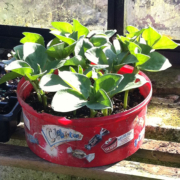
 The Bridge Cottage Way
The Bridge Cottage Way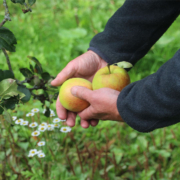 The Bridge Cottage Way
The Bridge Cottage Way the Bridge Cottage Way
the Bridge Cottage Way The Bridge Cottage Way
The Bridge Cottage Way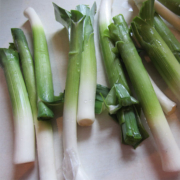
 The Bridge Cottage Way
The Bridge Cottage Way the Bridge Cottage Way
the Bridge Cottage Way
Leave a Reply
Want to join the discussion?Feel free to contribute!